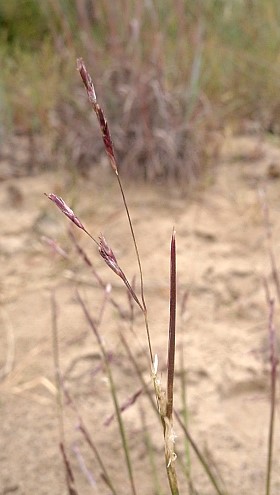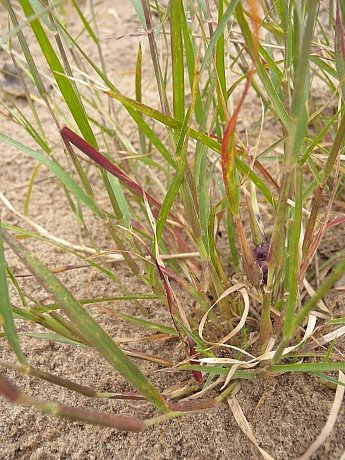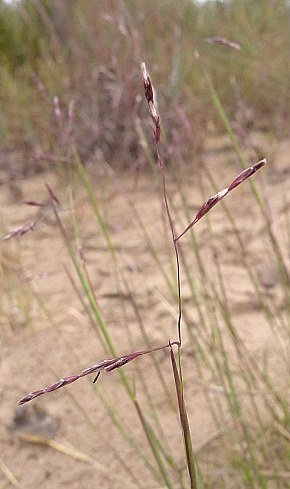
Each spikelet of this panicle has a pair of glumes (infertile scales) below, while above there are 2-5 florets with their lemmas (outer fertile scales) and paleas (inner fertile scales). The purplish glumes are 2-3 mm. long, narrowly lanceolate, single-veined, and glabrous. The purplish lemmas are 3-4 mm. long, oblong-lanceolate, and 3-veined; the marginal veins have fine white hairs that are short, and sometimes the central vein of each lemma has such hairs as well. The tip of each lemma has a pair of rounded lobes and a short awn (1 mm. or less in length) between them. Adjacent to each floret, there is a double-keeled palea that is a little shorter than the lemma; the palea has relatively long fine white hairs along its keels. Each floret consists of an ovary, a pair of feathery stigmata, and 3 stamens with purple anthers. In addition to the spikelets of the exerted panicle, there are self-fertile spikelets (cleistogamous) that remain hidden within the swollen sheaths. The blooming period occurs from late summer to early fall. Spikelets of the exerted panicle are cross-pollinated by the wind. During the fall, the florets of both the panicle's spikelets and hidden spikelets are replaced by grains about 2 mm. in length. Because the culms have a tendency to break apart at their nodes, the sheaths containing the grains of hidden spikelets are free to roll about in the wind. In this manner, the grains are distributed to new areas. The root system consists of a tuft of fibrous roots.
Cultivation: Sand Grass prefers full sun, dry conditions, and loose sandy soil where ground vegetation is sparse. Most growth and development occurs during the summer. Because this grass has a C4 metabolism, it is able to withstand hot dry weather better than most grasses.

Range & Habitat: The native Sand Grass is occasional in sandy areas of northern and western Illinois; elsewhere within the state, it is rare or absent (see Distribution Map). Habitats include sandy hill prairies, dry sand prairies, dry sandy savannas, sandy areas along major rivers, and partially stabilized sand dunes along Lake Michigan. This grass is a pioneer species that is largely restricted to habitats where there is some drifting sand.
Faunal Associations: Very little is known about floral-faunal relationships for this obscure grass. During the winter, the Snow Bunting and probably other granivorous songbirds eat its seeds. Grasshoppers that prefer sandy habitats may consume its foliage.
Photographic Location: A partially stabilized sand dune along Lake Michigan at the Indiana Dunes State Park in NW Indiana.

Comments: Sand Grass is the only member of its small genus in Illinois. Sometimes this grass becomes attractive when its spikelets and foliage assume a purplish color during the late summer and fall. The existence of cleistogamous spikelets within its sheaths is an unusual characteristic for a species of grass. Even more unusual is the tendency of this grass to break apart at its nodes, allowing its grain-bearing sheaths to roll around in the wind like a tumbleweed. This grass is clearly well-adapted to the open sandy habitats in which it occurs. It has yet another unusual characteristic – unlike other grasses, the foliage of this grass is supposed to have an acidic taste. It is difficult to distinguish Sand Grass from other grasses until its purplish spikelets are produced. At that time, it can be readily identified by the fine white hairs along the veins of its lemmas (fertile outer scales) and the even longer white hairs along the keels of its paleas (fertile inner scales). This grass also has tufts of white hair at the bases of its leaf blades – this is a trait that it shares in common with Eragrostis spp. (Love Grasses).